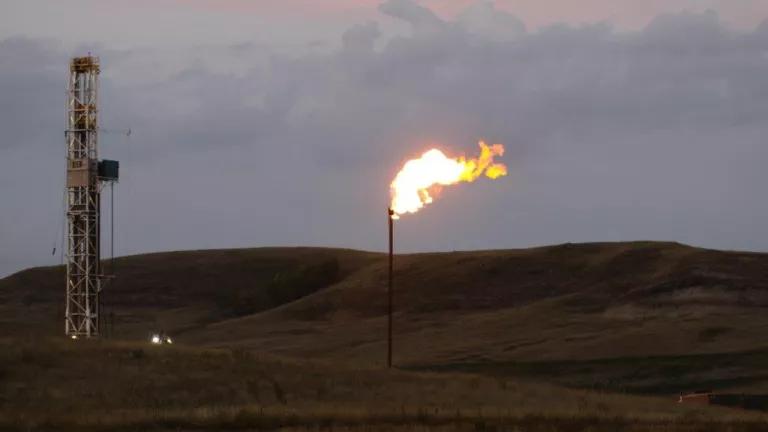Climate Deal: What It Means for Public Lands
The overall proposal includes the largest investments in climate change programs in history, but it also comes with an oil and gas industry chestnut.

Under the Senate's proposal, methane flaring--a significant source of greenhouse gas emissions--must either stop, or companies must pay for the wasted gas.
With the sudden revival of Democrats’ climate investment bill, the Senate has released a budget proposal that ends many harmful handouts to the fossil fuel industry, helps ensure taxpayers won’t pay for industry messes, and raises significant new revenues. The overall proposal includes the largest investments in climate change programs in history, but it also comes with an oil and gas industry chestnut that ties federal renewable energy development to expanded federal oil and gas development for the next decade.
It’s been almost a year since the House of Representatives unveiled a budget proposal that, for the first time in decades, advanced a suite of fiscal reforms that ended egregious handouts to oil and gas companies drilling on federal public lands. Today, most of those reforms have survived the intense Senate negotiations to advance climate investments in this country at a pivotal moment in the global race to mitigate climate change.
In the Senate’s climate deal, many of the historic harms of the federal fossil fuel system are righted. For a century or longer, federal public lands in the U.S. have been siphoned off to oil and gas companies at prices amounting to pocket change. With per acre rents as low as $1.50/year and bids for those acres starting at just $2, oil and gas companies have snatched up tens of millions of acres of public lands, closing them off to other uses. Furthermore, industry held most of the cards in terms of where to lease, reserving the right to nominate and lockup lands at their choosing. Meanwhile, where industry has developed leases, these companies have left behind a legacy of uncapped, leaky wells, damaged ecosystems, and out-of-control methane emissions. For decades, the companies who caused these externalities did not bear the costs. They essentially had a liability shield worth billions of dollars and taxpayers bore those costs.
To address these historic problems, the Senate’s deal would:
- Increase royalty rates on federal onshore leases from 12.5% to at least 16.67% over the next 10 years, with royalties on reinstated leases rising to 20%.
- Increase minimum bids—or the amount companies must offer per acre during lease sales—from $2/acre to at least $10/acre for the next 10 years.
- Increase rental rates for federal onshore leases more quickly and initially double them from $1.50/acre to $3/acre. After two years, rents would rise to $5/acre and at least $15/acre during year nine and onward. For reinstated leases, the rental rate gets set at $20/acre.
- Impose an “expression of interest” fee of $5/acre on companies looking to nominate acres for lease to the Bureau of Land Management for a future lease sale.
- End non-competitive leasing, which allowed companies to anonymously procure leases at cut rate prices. History has shown that while this type of leasing expanded the footprint of leasing, they rarely resulted in concerted development.
- Increase bonding requirements, establishing minimum bonding levels not previously set by statute. If passed, bond rates would be set at $150,000 for individual leases, $500,000 for statewide bonds (applying to all federal leases within a single state), and $2 million for nationwide bonds (applying to all federal leases held by the company throughout the U.S.). These represent increases of at least 15x above current levels set by regulation.
- Expand methane fees, clarifying that royalties must be paid for all gas produced from a federal lease, even where that gas is currently being vented, flared, or lost via poorly maintained transmission infrastructure. This mechanism will help to greatly reduce climate emissions associated with methane wasting.
NRDC has long advocated for these changes, and it’s a major step forward to see versions of them proposed by both the House and Senate. However, this week’s Senate proposal comes with a harmful provision that could lock in high levels of dependence on oil and gas well beyond 2030.
In short, the Senate proposal would require, prior to issuing rights of way (basically leases) to new solar and wind development on federal lands, the Bureau of Land Management to show that it has offered significant areas for lease to oil and gas companies. Put more simply: to develop renewable energy on federal lands, we must now continue high levels of federal oil and gas leasing even when there is no demand for these lands for drilling. And the requirement comes even as industry sits on thousands of unused drilling permits, millions of acres of undeveloped leases, and no stated desire to ramp up development to alleviate prices at the pump and the inflation they’re creating.
Nonetheless, the Senate’s proposed climate investments would significantly advance the clean energy transition and slash U.S. greenhouse gas emissions. And the proposed oil and gas reforms would represent a historical improvement in addressing decades of inequity given how public lands have been managed to favor industry first. But tying those investments to increased levels of oil and gas development that we simply do not need—and that industry has often not even asked for—is a mystifying step backward in our challenge to confront global emissions and stave off the worst effects of climate change.
On balance, this bill will move us in the essential direction we need to tackle the climate crisis and should pass without delay.



